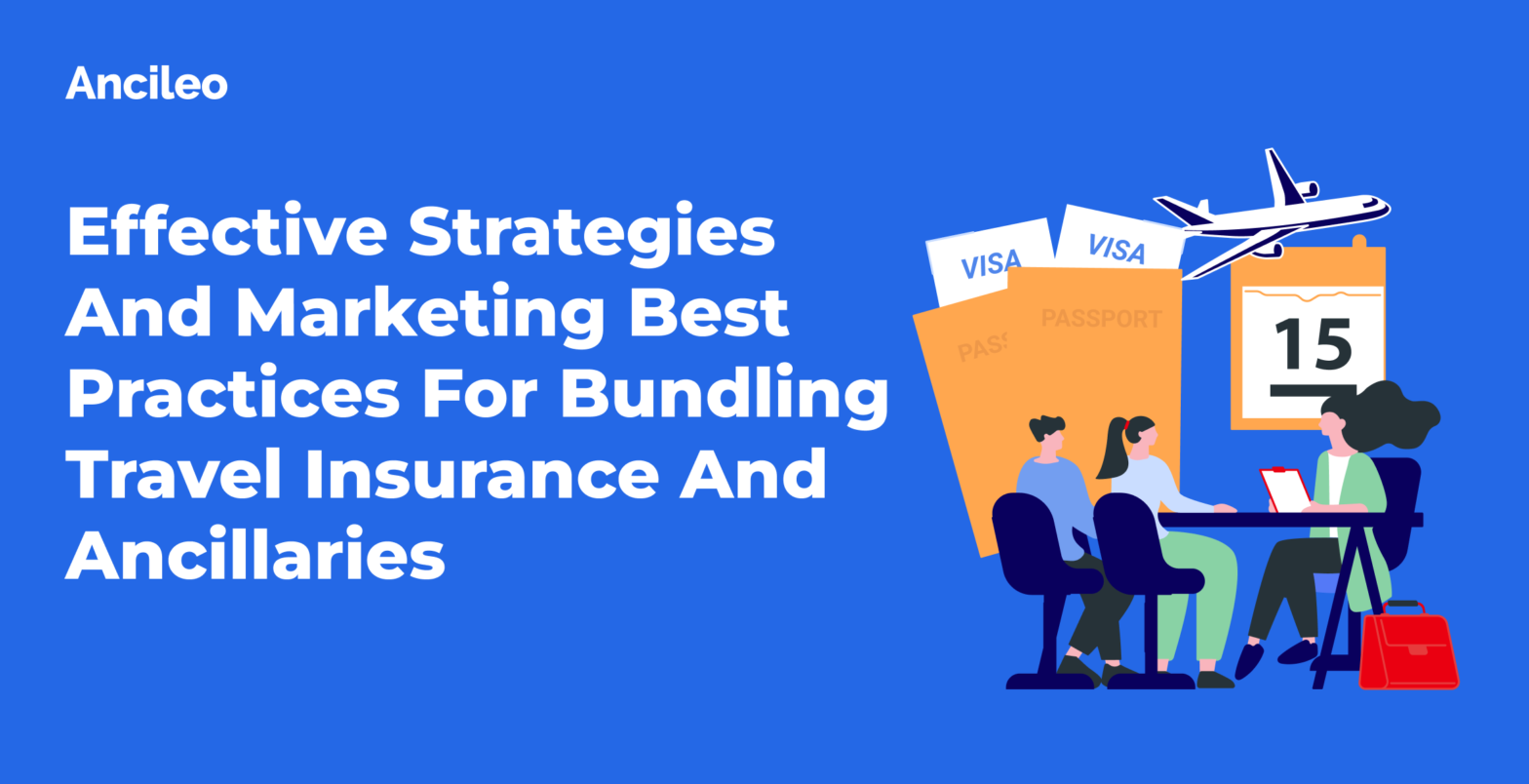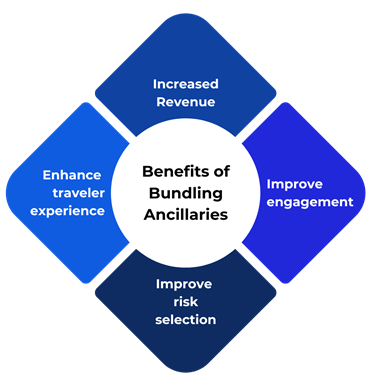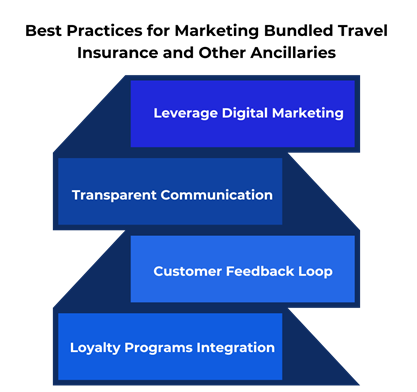
Airlines and travel insurers recognize the growing importance of bundling travel insurance and other ancillaries. This strategy is what distinguishes their brand from their competitors. However, it’s not enough to survive in the hypercompetitive landscape of travel. Effective ancillary bundling and marketing should always go hand in hand to boost ancillary revenue.
In this article, we’ll examine the most effective strategies for effective bundling of travel insurance and other ancillaries, as well as the best practices for marketing them.

Over the past years, airlines have been bundling products and services to bump up their ancillary strategies, with the goal of ultimately transforming the entire journey experience of travelers even at the point of booking.
It’s already a common sight for airlines to bundle pre-flight services like priority boarding and baggage allowance upgrades, as well as in-flight services such as meals, and in-flight entertainments. Many of them even go beyond by partnering with travel insurers, bundling travel insurance in their core offerings.
For both airlines and travel insurance providers, bundling yields a number of benefits. Here are just some of them:
Without an effective bundling strategy, it’s easy to get lost in the sea of competition. Travelers are always exposed to so many options when they’re in the market for their next trip. And if you want to be the main influencer of their decision-making process, it’s best to offer bundles that stand out from the rest.
Here are some best strategies for effective bundling of travel insurance and other ancillaries:

One of the most common yet effective ancillary bundling strategies is to offer customized bundling options based on passenger data. Gain access to historical data such as travelers’ past booking behavior, preferences, and demographics so that you can develop personalized bundle packages that are more likely to appeal to individual travelers.
For instance, a business traveler may value priority boarding, in-flight Wi-Fi, and comprehensive travel protection. On the other hand, families may prioritize excess baggage allowance, onboard entertainment, and coverage for lost/stolen baggage. Having access to these kinds of insights allows you to easily tailor bundles to specific customer segments, which in turn, increases the likelihood of conversion and maximizes revenue.
Cross-selling and upselling strategies can also be highly effective in increasing the uptake of bundled ancillaries. As evident in our latest report, Top 50 Airlines Travel Insurance Benchmark, many of the leading airlines have found success in incorporating cross-selling and upselling approaches within their bundling strategies. They integrate travel insurance and other ancillaries seamlessly into the booking experience, making it easy for travelers to add these extras to their plans.
A common strategy among the leading airlines is that they offer a discounted bundle that includes travel insurance, seat selection, and extra baggage allowance at the time of booking. These options are presented as value-added packages, increasing the perceived value of the purchase and encouraging travelers to upgrade their booking.
The use of value-based pricing models helps create a perception of a better deal for travelers. Bundling travel insurance and other ancillary services together and offering them at a slightly higher price can make these offerings more attractive to travelers and increase the likelihood of purchase.
A common scenario that exhibits this strategy is the offering of a bundle that includes seat selection, extra baggage allowance, and flexibility changes at a competitive yet attractive price for travelers.
Creating bundles that are tailored to specific destinations or seasons can also be an effective strategy. For example, airlines can offer bundles that include travel insurance, car rentals, and local tours for popular holiday destinations. Bundling products and services for these purposes can help airlines and travel insurers cater to specific customer needs and increase the perceived value of the bundle.
Getting your bundled ancillaries known is the next logical step. And while it’s true that there are already a myriad of marketing channels and strategies in place, you can’t just go out there advertising that you have the best bundled products. This bold approach poses a considerable risk as you may be left spending blindly on uncertain marketing efforts.
Here are some best practices for marketing bundled ancillaries:

Airlines and travel insurers can utilize digital marketing strategies such as search engine optimization (SEO), content marketing and social media for promoting bundled ancillaries. Using these strategies, create engaging contents that emphasize the benefits and savings of bundles, using targeted keywords to improve search engine visibility.
Having a solid digital marketing plan can help get your message across different channels into the screens of your target audience. This is currently the most powerful marketing strategy, given that people nowadays spend a significant amount of time on their screens.
Transparent communication is essential when marketing bundled ancillaries. Ensure that the value and components of the bundle are clearly communicated, including any restrictions or limitations. Providing detailed descriptions and FAQs on the airline’s website can help customers understand what each bundle includes and make an informed decision. Clear and transparent communication can help build trust with customers and reduce the risk of dissatisfaction.
Gathering customer feedback on bundled offerings is crucial for refining and improving the bundles over time. Airlines and travel insurers can conduct surveys post-flight to gather insights on bundle satisfaction and use this data to make adjustments to future offerings. Adhering to this practice helps boost customer satisfaction and drive repeat business.
Integrating bundled ancillaries into the existing loyalty programs of airlines can be a very effective way to entice customers into choosing bundled offerings. One approach is to offer points or miles for purchasing ancillaries. For instance, airlines can offer travelers bonus miles for purchasing a bundled package that includes travel insurance, seat selection, and extra baggage allowance.
Another approach is to offer discounts on bundled ancillaries for loyalty program members. For example, airlines can offer a 10% discount on bundled packages for members of their frequent flyer program.
By integrating bundled ancillaries into their loyalty programs, airlines and travel insurers can increase customer engagement and drive ancillary revenue.
The key takeaway is clear: to succeed in maximizing revenue and improving customer satisfaction, airlines and travel insurers must continuously refine their bundling strategies. By staying attuned to customer preferences, embracing innovative bundling approaches, and leveraging effective marketing practices, these players can create compelling bundled offerings that resonate with travelers. Those who innovate and adapt their bundling strategies are poised to thrive in the evolving landscape of the travel industry.